Marble stone has been revered for centuries for its natural beauty and durability. From ancient monuments to modern homes, this exquisite stone has made a significant impact on architecture and design. In this article, we’ll discuss the unique properties of marble stone, its advantages, and why it remains a popular choice for both indoor and outdoor applications.
Properties of Marble Stone
Marble is a natural stone with distinct characteristics that set it apart from other materials. Understanding its properties can help you appreciate its allure and make informed decisions for your next project.
Formation and Composition
Marble is primarily composed of calcite, a mineral derived from limestone. Over millions of years, intense heat and pressure transform limestone into marble, giving it a crystalline structure. This process creates the stunning veining patterns that make each piece of marble unique.
Variety of Colors and Patterns
Marble is available in a wide range of colors, from classic whites and blacks to more exotic greens and reds. The variety in veining and color allows designers to use marble to create both subtle and dramatic effects in their projects.
Advantages of Using Marble Stone
Marble stone offers numerous benefits, making it a preferred material for construction and design projects. Let’s explore some of the key advantages of using marble stone.
Aesthetic Appeal
The visual appeal of marble is undeniable. Its elegant veining and smooth surface make it a standout choice for luxury interiors. Marble can be polished to a high shine or honed for a more matte finish, depending on the desired look.
Longevity and Durability
Marble is a durable stone that can last for decades with proper care. While it may require more maintenance than some other materials, its long lifespan and timeless appeal make it a worthwhile investment.
Interior and Exterior Applications of Marble Stone
Marble stone is a versatile material that can be used in a variety of ways. Let’s look at some of the most popular applications for marble in both indoor and outdoor settings.
Marble in Interior Design
In interior design, marble is often used for countertops, backsplashes, and flooring. It’s also a popular choice for bathroom vanities and fireplace surrounds. Marble’s natural elegance makes it suitable for both traditional and contemporary designs.
Marble in Landscaping and Exteriors
Marble is not just for indoor use; it can also be utilized in outdoor spaces. From marble pavers to garden sculptures, the stone’s durability and weather resistance make it an excellent option for outdoor design. Marble columns, fountains, and walkways are just a few examples of how marble can enhance an exterior landscape.
Caring for Marble Stone: Best Practices
To keep marble looking its best, it’s essential to follow proper maintenance practices. Here are some tips for taking care of your marble surfaces.
Preventing Scratches and Etching
Marble is susceptible to scratches and etching from acidic substances. Use coasters, cutting boards, and trivets to protect marble countertops from spills and hot objects. Additionally, avoid dragging heavy objects across marble flooring to prevent scratches.
Professional Restoration
Over time, marble may lose its luster due to wear and tear. Professional restoration services can help restore the stone’s shine and address any damage. Regularly hiring a professional to polish and reseal marble surfaces can significantly extend their lifespan.
Conclusion
Marble stone is a beautiful and durable material that has stood the test of time. From ancient architecture to modern interiors, marble continues to captivate with its elegance and versatility. By understanding its properties, applications, and maintenance needs, you can make the most of marble in your home or outdoor space. Whether you’re aiming for a luxurious kitchen, an inviting garden, or an elegant entryway, marble stone remains a timeless and reliable choice.

